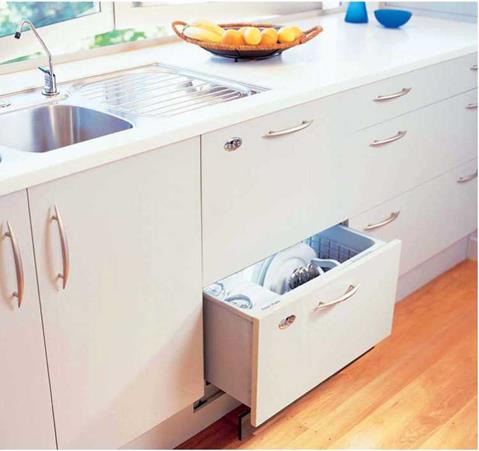Dishwashers Are Shaping Up
Dishwashers have changed quite a bit in recent years. They use a lot less water, which translates into lower energy use for water heating. In 1978, water use by dishwashers ranged from 11 gal. to 15 gal. for a normal dishwashing cycle. By 2000, that usage had dropped to 6 gal. to 10 gal.
As water use has gone down, total energy use has also dropped, while the proportion of energy use for processes other than water heating has risen. In 1978, 83% of the total energy use for dishwasher operation was for heating water; 10% was for motor operations, and 7% for drying. By 1994, energy use for water heating had dropped to 56%, according to a 2003 Virginia Tech report.
However, that does not mean most dishwashers are as energy efficient as they could be. Nearly all dishwashers today have booster heaters that increase the temperature of incoming water to about 140°F to improve wash performance. An integral electric element provides this heat, and it can use a lot of electricity. Recent independent testing shows that booster heaters operate throughout the dishwashing cycle, resulting in total electricity use per cycle of 2.0 to 3.5 kwh. Used an average of 215 times per year (the frequency DOE assumes), a dishwasher could easily consume more electricity annually than a refrigerator. More research is needed to determine the significance of this electricity use.


 Dishwashers vary considerably in their energy use, much more so than refrigerators. For comparison, dishwashers are rated by the federal government according to their energy factor (EF), a measurement based on the energy usage for an average number of cycles (a completely different formula than the one used to rate cooking appliances).
Dishwashers vary considerably in their energy use, much more so than refrigerators. For comparison, dishwashers are rated by the federal government according to their energy factor (EF), a measurement based on the energy usage for an average number of cycles (a completely different formula than the one used to rate cooking appliances).
The higher the EF, the more efficient the dishwasher: The current federal standard mandates a minimum EF of 0.46; Energy Star dishwashers must meet a minimum EF of 0.65. The most-efficient dishwashers have an EF that approaches or slightly exceeds 1.0. Although the EF is used to compute the annual energy consumption and cost estimates found on the EnergyGuide label on many appliances, the EF itself might not appear there.






Leave a reply